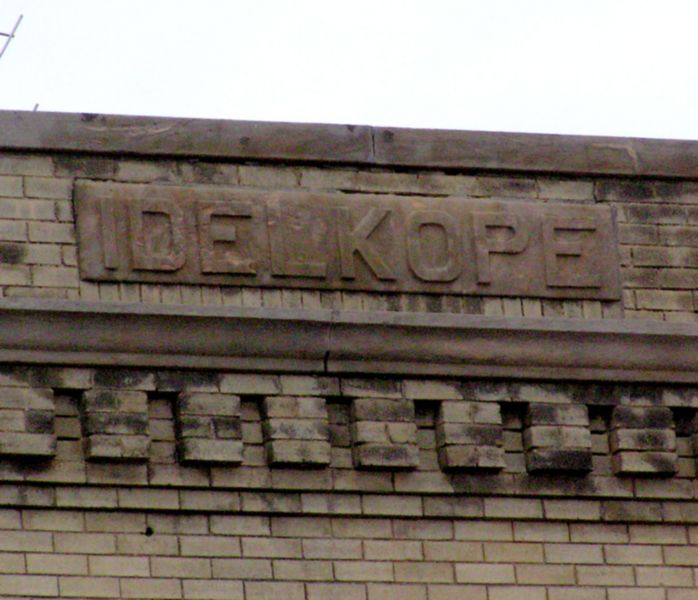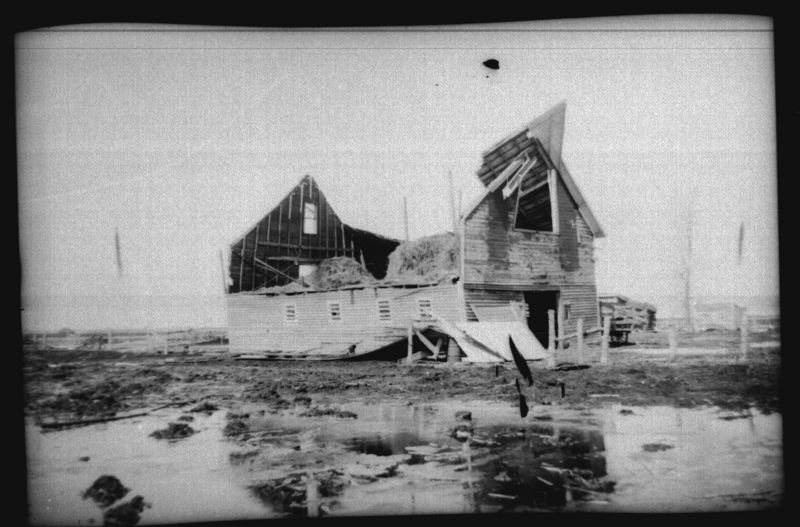 The idea that a tornado could take the roof clean off sounds like an exaggeration — but there’s ample evidence that’s exactly what happened here. These photos were from the 1950s at the latest — 1920s at the earliest — all of which are on the early side when it comes to rural infrastructure in this part of the world. Put yourself in this farm family’s shoes: It’s raining like hell, you’ve got no TV, no telephone, no radio (and even if you did, there was no ’emergency broadcast system’, no NOAA weather radio, and even a little rain interferes with them all), you’re huddled around a candle in your dirt cellar, and you hear the rumbling — like a train, but the nearest tracks are 10 miles away. You’ve got nothing you can do but wait it out, and hope it doesn’t come too close of the house. They’re lucky it was just the top of the barn — as you can see in the last photo, they were able to put things back together, hopefully without too much loss.
The idea that a tornado could take the roof clean off sounds like an exaggeration — but there’s ample evidence that’s exactly what happened here. These photos were from the 1950s at the latest — 1920s at the earliest — all of which are on the early side when it comes to rural infrastructure in this part of the world. Put yourself in this farm family’s shoes: It’s raining like hell, you’ve got no TV, no telephone, no radio (and even if you did, there was no ’emergency broadcast system’, no NOAA weather radio, and even a little rain interferes with them all), you’re huddled around a candle in your dirt cellar, and you hear the rumbling — like a train, but the nearest tracks are 10 miles away. You’ve got nothing you can do but wait it out, and hope it doesn’t come too close of the house. They’re lucky it was just the top of the barn — as you can see in the last photo, they were able to put things back together, hopefully without too much loss.
Category: Uncategorized
Victorian Halloween: Black-Face
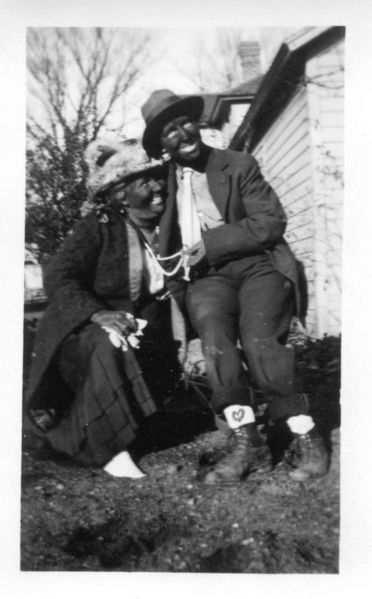
Helene and Mrs. Faucher had the best of intentions when they dressed up for Halloween, 1916, in blackface — little did they know that, ninety-one years later, people from all over the world will be sending off disgusted electronical-correspondences to a writer in North Dakota who published their photo for everyone to see.
No, please, withhold your electronical- correspondences; It’s Halloween, a time when, even though a few buck the system and go as princesses and Batmans (and the stores are full of slutty pirate-wench outfits for pre-teen girls, but that’s another issue entirely), we encourage our kids to dress up as murderers and the murdered, thieves and monsters, and all sorts of terrible and horrible beings. If Halloween is about being scary, evoking fear of harm, who can think of something more monstrous, recalling more violence and pain, than these costumes?
Helene and her partner-in-crime were probably trying to be funny — and how outgoing! These ladies were born around the time the Civil War was ending, growing up at the height of Victorian conservatism, and here they were dressing up as popular media characters of the time. Too bad they picked something that their great-grandkids would wince at whenever the photo album was brought out. Helene and her girlfriends were tech-savvy for the time: they took many candid, personal photos of themselves, some of which ended up in my Victorian Ladies Gone Wild section.
Fertile Business Card
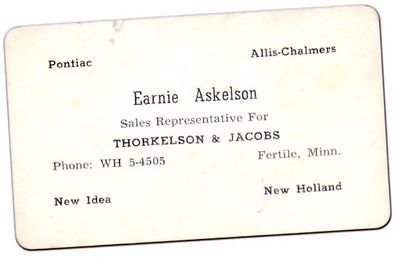
Earnie Askelson lived in the small city of Fertile, MN, one of the larger stops between Fargo and Grand Forks along US 75. During the 1950s, Thorkelson & Jacobs was an implement dealer, catering to the huge farming community in the region. As you might notice, firm lines weren’t drawn between the types of machines with engines: cars were sold along with the plows and harvesters. For a small town, I’ll bet this helped against spreading the expert mechanics too thin between dealerships. Thorkelson & Jacobs no longer exists –if you’re looking for a Pontiac, Christian Motors is the GMC dealership in Fertile now.
More 1960s Halloween
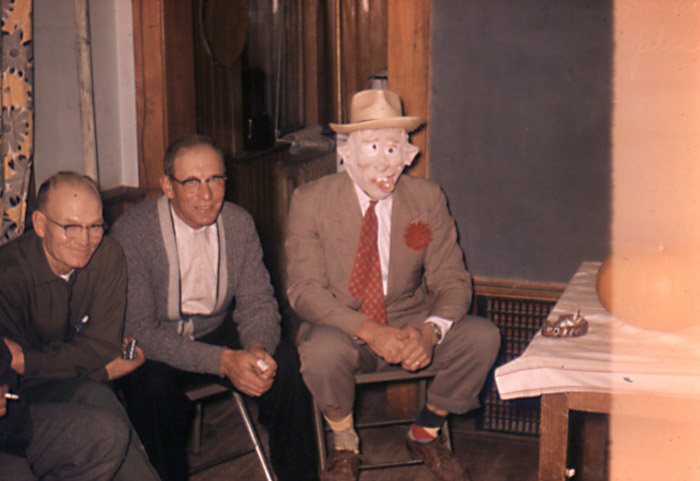 Sing along with me: “One of these things is not like the other; one of these things is not quite the same…” I really hope this photo was taken around Halloween, otherwise Gunther has got some ‘splaining to do. If you look closely, he didn’t just grab some kid’s mask and put it on for the photo: he’s got mismatched ugly socks, an over-the-top boutonniere (matching his tie, no less!), all wrapped in an ill-fitting suit. Gunther was probably quite disappointed when nobody else wore their costumes to the party, coincidentally held on Halloween though no costuming was ever mentioned. He’s still wearing the costume to try and remain inconspicuous, as though he just casually stopped by in whatever he had on that day. Poor, poor Gunther.
Sing along with me: “One of these things is not like the other; one of these things is not quite the same…” I really hope this photo was taken around Halloween, otherwise Gunther has got some ‘splaining to do. If you look closely, he didn’t just grab some kid’s mask and put it on for the photo: he’s got mismatched ugly socks, an over-the-top boutonniere (matching his tie, no less!), all wrapped in an ill-fitting suit. Gunther was probably quite disappointed when nobody else wore their costumes to the party, coincidentally held on Halloween though no costuming was ever mentioned. He’s still wearing the costume to try and remain inconspicuous, as though he just casually stopped by in whatever he had on that day. Poor, poor Gunther.
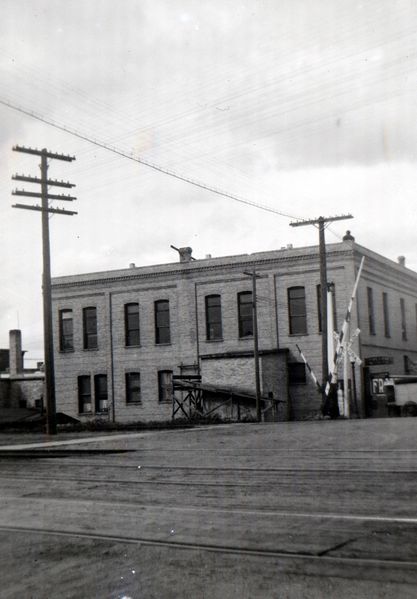 The back of a nicely-made brick building, in an unknown town. Excellent brickwork, ball finial at the corner, backing the railroad — but no identifying signs on this site. I did my best, scanning and rescanning at highest resolution, using PShop tricks to try and coax out the words on the overhang, on the far right side, with no luck. It’s just not readable. I know I called it an ‘old brick building’ in the filename, but it was definitely not old at the time of the photo: taken in the 1920s or 1930s, it was probably 30 years old, at the most — if it still stands, it’s around its 100th birthday these days. [more]
The back of a nicely-made brick building, in an unknown town. Excellent brickwork, ball finial at the corner, backing the railroad — but no identifying signs on this site. I did my best, scanning and rescanning at highest resolution, using PShop tricks to try and coax out the words on the overhang, on the far right side, with no luck. It’s just not readable. I know I called it an ‘old brick building’ in the filename, but it was definitely not old at the time of the photo: taken in the 1920s or 1930s, it was probably 30 years old, at the most — if it still stands, it’s around its 100th birthday these days. [more]
Scary House In The Woods
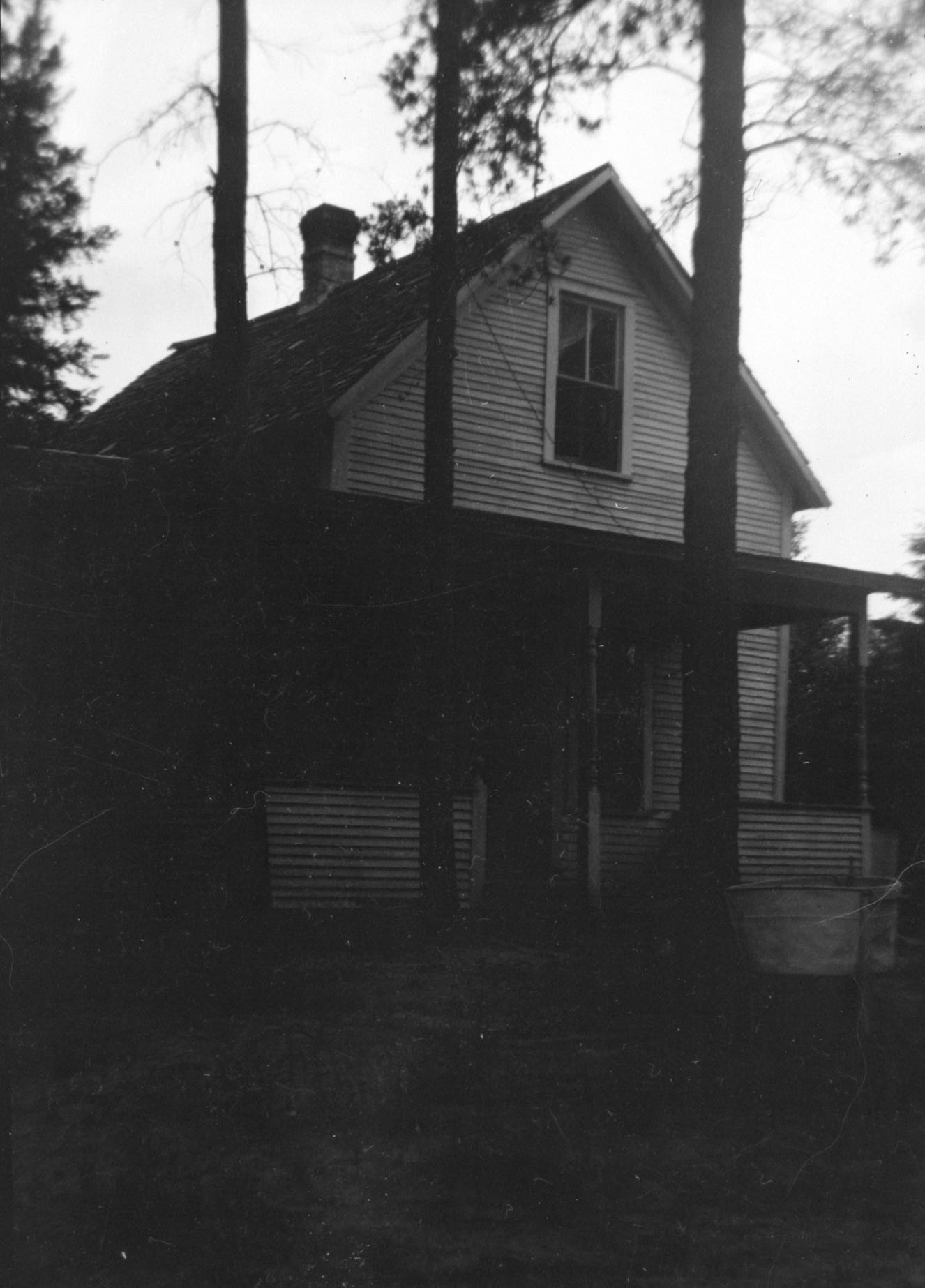 I really don’t have any proof that this house is haunted, or contains a murderer, or was built on an indigenous-peoples burial ground, but it sure looks Halloweeny. [more photos in this series]
I really don’t have any proof that this house is haunted, or contains a murderer, or was built on an indigenous-peoples burial ground, but it sure looks Halloweeny. [more photos in this series]
Halloween in the 1960s
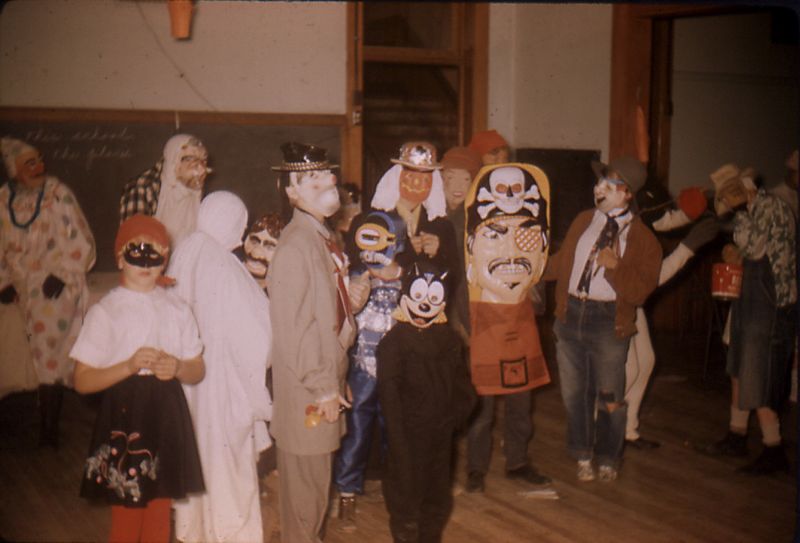 Greetings from Vintage Halloween, 1960s! This came from a set of slides that belonged to a family living on a West-Central Minnesota farm during the mid-20th-century. I’m not exactly sure what school this was — Georgetown, maybe Felton — but it’s quite a flashback to see schools letting the kids dress up for Halloween in the classroom. Two hobos (three if you count Dr. Jack-O-Lantern in the back), a creepy clown, and a poodle-skirted, bemasked pirate are the more classic, but the kid in the middle with the branded SCUBA-diver costume gets my vote for best costume: I want one.
Greetings from Vintage Halloween, 1960s! This came from a set of slides that belonged to a family living on a West-Central Minnesota farm during the mid-20th-century. I’m not exactly sure what school this was — Georgetown, maybe Felton — but it’s quite a flashback to see schools letting the kids dress up for Halloween in the classroom. Two hobos (three if you count Dr. Jack-O-Lantern in the back), a creepy clown, and a poodle-skirted, bemasked pirate are the more classic, but the kid in the middle with the branded SCUBA-diver costume gets my vote for best costume: I want one.
The Idelkope Building
Stay At The Auto-House
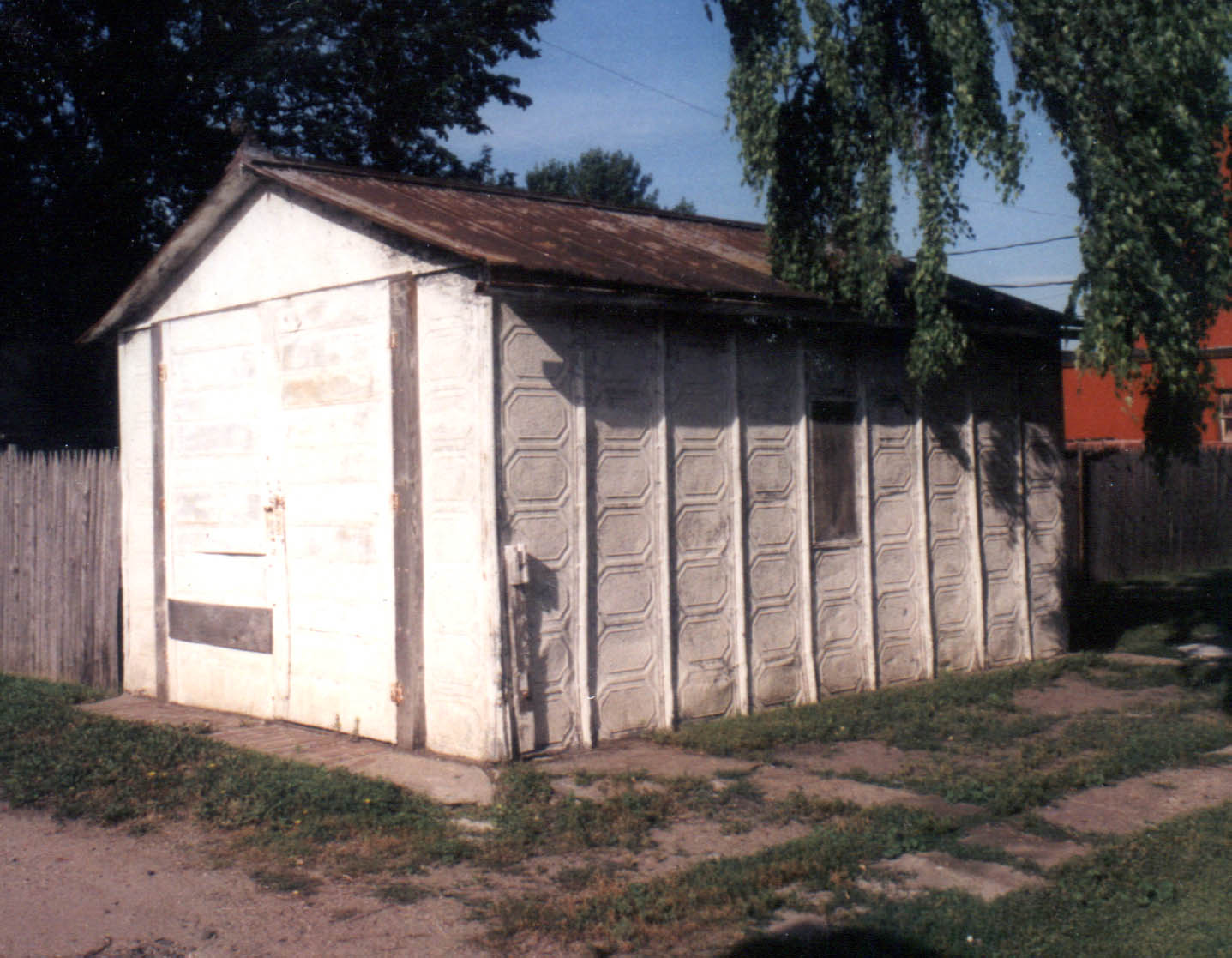 This funny little tin house is a throwback to an earlier time — one before houses were automatically assigned a wide-open, roofed, cement-floored siamese twin known as a ‘garage’. When people started buying cars they needed someplace to put them, and one of the competitors in the ‘automobile storage kit’ was the Rusk Auto-House, an overtly-fancy steel shed that owes its beauty to its Fargo-based manufacturer: a producer of embossed tin ceilings and copper cornices. Sadly, the metal shortages of the World Wars put an end to tin ceilings, copper cornices, and, as you might guess, stylish little steel car-homes.
This funny little tin house is a throwback to an earlier time — one before houses were automatically assigned a wide-open, roofed, cement-floored siamese twin known as a ‘garage’. When people started buying cars they needed someplace to put them, and one of the competitors in the ‘automobile storage kit’ was the Rusk Auto-House, an overtly-fancy steel shed that owes its beauty to its Fargo-based manufacturer: a producer of embossed tin ceilings and copper cornices. Sadly, the metal shortages of the World Wars put an end to tin ceilings, copper cornices, and, as you might guess, stylish little steel car-homes.
Minnesota Kaiser – 1947
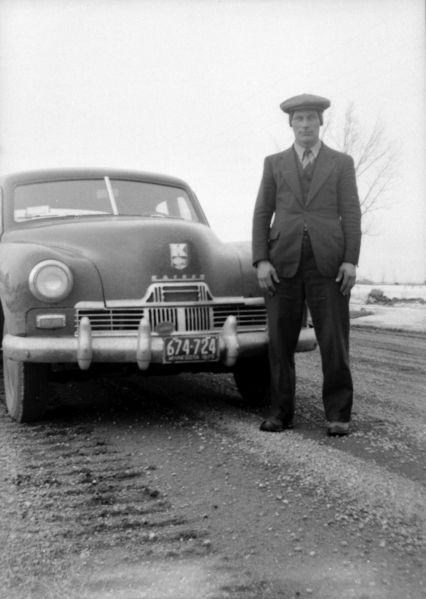 My great-uncle (not the guy in the picture) had a Kaiser Frazer — he owned it until he needed to clear out his farmstead, at which time the Frazer moved out to my uncle’s farm, where it has sat for almost twenty years now, progressively and slowly turning into a pile of rusty dust. Kaiser wasn’t a big manufacturer, and there weren’t a lot around, so I was rather surprised to turn up a whole bunch of pictures of another Kaiser taken within twenty miles of where my great-uncle lived. How’d that happen?
My great-uncle (not the guy in the picture) had a Kaiser Frazer — he owned it until he needed to clear out his farmstead, at which time the Frazer moved out to my uncle’s farm, where it has sat for almost twenty years now, progressively and slowly turning into a pile of rusty dust. Kaiser wasn’t a big manufacturer, and there weren’t a lot around, so I was rather surprised to turn up a whole bunch of pictures of another Kaiser taken within twenty miles of where my great-uncle lived. How’d that happen?
Grandpa Vernon, as always, had the answer: there was a Kaiser dealer out that way, so there was ample opportunity for local farmers to buy ’em. In the post-war booming, accompanied by REA, improved roads and transportation, and new farming techniques, farmers did pretty good for themselves, plenty enough to warrant spending a bit on a nice new car.
So, as you might have noticed, I’ve been scanning and uploading more of my Early 20th Century Minnesota Farmland series — if I were more organized, I could point out the new ones better, but, sadly, there’s just so many of them. New images are primarily the last 1/4 of the Black Album, and all of the Red Album.
